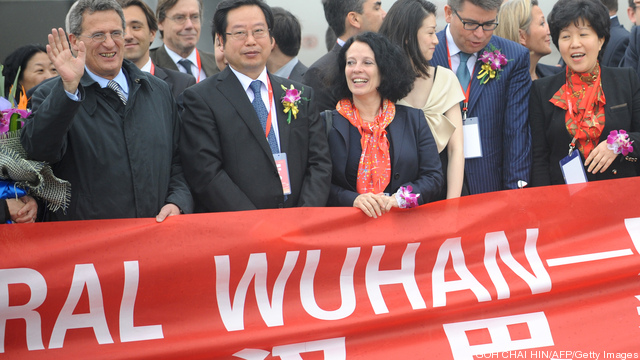
Westport Innovations said Tuesday it reached an agreement with Caterpillar to use natural gas technology for mining trucks and locomotives. Terms of the deal were not disclosed. The Vancouver-based company makes direct injection, natural gas technology for heavy-duty vehicles. “The substantial price difference between natural gas and diesel fuel is resulting in a strong financial incentive to enable off-road applications to take advantage of low natural gas energy costs without sacrificing operational performance,” said David Demers, chief executive officer of Westport Innovations. Read more: http://www.foxbusiness.com/markets/2012/06/05/caterpillar-westport-team-up-on-natgas-vehicles/#ixzz1wvszEJsH
Corporate
Sign up and get Breaking Energy news in your inbox.
We will never sell or share your information without your consent. See our privacy policy.The IFC Approach to Clean Energy: http://on.ifc.org/HDSIMC IFC_org
We’re trying to estimate demand for electric charging units…can anyone help determine demand in a given area?
By Peter Gardett
While the “food versus fuel” debate has grabbed headlines, biofuels technology worldwide has been accelerating down the learning curve and is at a “tipping point” for commercialization. Keep reading →

Eni SpA, Italy’s biggest energy company by market value, said Tuesday that a refining boom in the Middle East is putting pressure on European refiners because the MidEast producers, who have lower costs, are now entering the market in Europe especially the Mediterranean. “Italy was a hub for Middle Eastern crude, but not anymore as Middle East [oil companies] are now vertically integrated,” Domenico Elefante, Eni’s executive vice president for refining, told Dow Jones Newswires on the sidelines of the Global Refining Summit in Barcelona. Elefante also said it isn’t a problem for Eni to replace Iranian barrels which are subject to western sanctions as the import volumes have been low. He didn’t provide further details on the volumes.
Waste Gas to Usable Energy: An Innovative Partnership at GE and Wuhan Iron and Steel
By Ryan Derouin
I spent last week at AISTech – one of the largest conferences of the year for the iron and steel industry – and conversations with attendees centered on how steel producers can implement new technology to remain competitive in the market. As companies around the world expand city skylines, put more planes in the sky and ships in the sea, and produce enough electronics to put them in the hands of millions of consumers, steel producers are being asked to meet a skyrocketing demand. In fact, by the year 2050, world steel production levels are expected to double from 2010 levels. Facing this rapid growth and the mounting global concerns about climate change, steel mill operators around the world are on the hunt for more reliable, efficient and productive sources of power to boost steel production capacity while simultaneously reducing the environmental impact of their operations.
Established in 1958, Wuhan Iron & Steel Group Corp (WISCO) is the first “giant” iron and steel corporation to operate in China since the founding of the People’s Republic of China in 1949, ranking fourth in production output in China and fifth globally. At the time WISCO and GE Energy began their business relationship in 2007, WISCO was making approximately 40 million tons of iron and steel a year, operating with traditional steam boilers. A rising demand for steel was driving the need for more electricity, eventually requiring up to 10 billion kilowatt hours per year. That level of energy consumption was unsustainable for WISCO and a costly drain on the public grid. Spurred by new legislation setting stringent regulations on steel mill efficiency in China, WISCO engaged GE Energy to develop and execute an innovative approach to power generation that would increase energy efficiency and profitability, all while reducing emissions and maintaining a high level of production. Keep reading →

Enbridge said it has secured funding for $2.6 billion in additional pipeline projects linking western Canadian oil to eastern markets, while Enbridge Energy Partners said it will spend $360 million to expand its crude-oil mainline system. Enbridge said its Eastern Access expansion projects will include the expansion of its Toledo pipeline, which connects with the Enbridge mainline in Stockbridge, Mich., and serves refineries at Toledo, Ohio, and Detroit, and a rereversal of its Line 9B from Westover, Ontario to Montreal to serve refineries in Quebec. The company previously announced plans for a rereversal of Line 9A from Sarnia, Ontario to Westover.

It is easy to enumerate the challenges facing the utility sector over the coming decade, but participants in DNV KEMA’s fifth “Utility of the Future” Summit in Washington, DC today were optimistic about the opportunities to build on what many pointed out was a relationship of deep trust with consumers and regulators.
Southern Company Services CEO Susan Story grabbed the conference’s attention with an easy command of extensive facts about the largest vertically integrated US utility’s efforts to adjust to changing operating and technology environments. She balanced the deep dives with illustrative examples and a strategic view of her industry’s changing place in the world. Keep reading →


